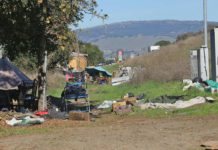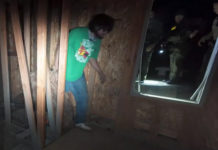Hollister
– Federal wildlife officials set aside nearly 44,000 acres in
San Benito County – most of it privately owned land – for the
California red-legged frog this week, a designation that has the
potential to affect how the property can be developed.
Some environmentalists, however, say the designation falls
dreadfully short of what’s needed to save the species from
extinction.
Hollister – Federal wildlife officials set aside nearly 44,000 acres in San Benito County – most of it privately owned land – for the California red-legged frog this week, a designation that has the potential to affect how the property can be developed.
Some environmentalists, however, say the designation falls dreadfully short of what’s needed to save the species from extinction.
On Wednesday, the U.S. Fish and Wildlife Service announced that it was designating 43,938 acres in the county as critical habitat for the frog – which is believed to have inspired Mark Twain’s 1865 story, “The Celebrated Jumping Frog of Calaveras County.” Statewide, about 450,288 acres were set aside in 20 counties this week.
A critical habitat designation does not affect private property rights nor preclude development. However, if a project planned for critical habitat land requires a federal permit or involves federal funding then plans must be approved by the FWS. Those who want to develop on land that is home to any threatened species, whether or not it is critical habitat, need FWS approval, according to Jim Nickles with the FWS.
Breeding, foraging areas
The presence of threatened species – such as the frog, which has been listed as a threatened species since 1996 – on land is a standard concern for developers, according to Ray Becker, the local representative of Arizona-based developer DMB Associates, which has plans to build a 6,800-house town in northern San Benito County.
“It’s certainly something, like all regulatory matters, that you have to pay attention to when looking to develop,” he said. The DMB project, El Rancho San Benito, isn’t located in the newly designated critical habitat.
The habitat – which includes breeding and foraging areas – established in San Benito County is separated into three areas:
n 20,037 acres, in south county, including the Pinnacles National Monument
n 14,285 acres in northwestern San Benito, including Hollister Hills and San Juan Oaks
n 9,616 acres southeast of Hollister, including the Paicines Reservoir and Tres Pinos Creek
A project to build nearly 200 houses and a 200-room hotel at San Juan Oaks Golf Club won’t face new difficulties because of the recent critical habitat designation, according to General Manager Scott Fuller. San Juan Oaks has already been working with the FWS to ensure that its development won’t cause trouble for either the red-legged frog and the California tiger salamander, which is also listed as a threatened species. In August, the FWS set aside more than 24,000 acres in San Benito as critical habitat for the salamander.
“It won’t have a negative affect on us because we’ve already taken (the frog) into account,” Fuller said.
Construction of the San Juan Oaks project is slated to start early this summer with the construction of nearly 60 homes.
Protecting habitats
While the critical habitat designation is ostensibly a victory for the coalition of environmental groups that have spent a decade fighting for habitat protection for the red-legged frog. Environmentalists, however, aren’t satisfied.
“Critical habitat can be the most effective tool for recovering endangered species, but this designation amounts to an extinction for the red-legged frog,” said Jeff Miller with the Center for Biological Diversity.
Miller said that laws protecting threatened species are ineffective if the habitats in which they live are not protected.
In 2001, the FWS designated 4.1 million acres statewide as critical habitat for the frog. After being sued by the Homebuilders Association of Northern California, the FWS reversed itself and agreed to remove the protection. In November, the FWS proposed to establish nearly 738,000 acres in California as critical habitat, but cut that by about 40 percent to the acreage finally designated this week. In cutting the proposed critical habitat, the FWS said that it used better maps that could more accurately determine which areas need designation. Also, it cited an economic analysis showing that the November proposal would have cost $497 million in lost development opportunities over 20 years.
Threats to the red-legged frog include predatory non-native species and habitat loss due to development, according for the Center for Biological Diversity.
Miller said that the Center for Biological Diversity and other environmental groups were going to consider taking their complaint to court in hopes of expanding the critical habitat for the red-legged frog.
“We’re certainly going to look at going to court to look at this,’ he said. “This is untenable for the frog.”







